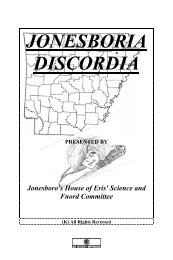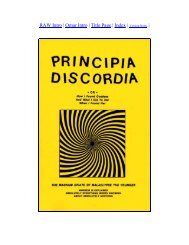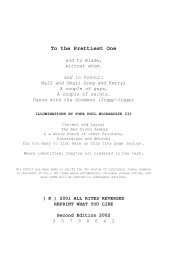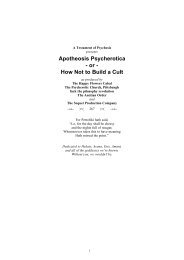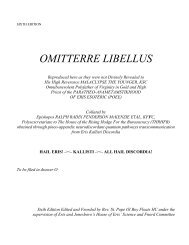Coincidance - Principia Discordia
Coincidance - Principia Discordia
Coincidance - Principia Discordia
Create successful ePaper yourself
Turn your PDF publications into a flip-book with our unique Google optimized e-Paper software.
C01NC1DANCE 41<br />
No wonder she is proud of her breasts. And, hence, quite naturally, she<br />
holds them, either to show them off, or to offer more conveniently their<br />
fullness ... *<br />
Statues of the goddess, holding her breasts in this "offering" position,<br />
have been found all over prehistoric Europe and Asia. They must have been,<br />
at one time, as common as the more familiar mother-with-child later<br />
adopted by Roman Christianity.<br />
In contrast, and despite the orality of Jesus himself, the Judeo-Christian<br />
faiths are strongly anal* and their stern Father God demands endless<br />
sacrifices, offers no joy on earth but only duty blindly obeyed, and threatens<br />
sadistic tortures (for an infinite number of years, according to some<br />
theologians) to anyone who crosses him. It almost seems as if history, at<br />
least in the Occident, repeats the pattern Freud found in the nursery, from<br />
oral bliss to anal anxiety.<br />
This was the opinion, in the last century, of the German folklorist J.<br />
Bachofen, of the American anthropoligist Lewis Morgan, and of Karl<br />
Marx's financial supporter and collaborator, Friedrich Engels. Their hypothesis<br />
of a single historical pattern, in which all societies evolve from matriarchal<br />
communism to patriarchal capitalism (and then back to communism,<br />
according to Engels), was widely accepted for about 50 years, but then<br />
evidence that conflicted with it began accumulating. Some societies were<br />
never matriarchal; some alleged matriarchies were actually only matrilineal—<br />
that is, descent and property were passed through the female line, but men<br />
still held the chieftainships or governorships; and, if some of Bachofen's<br />
inspired guesses about prehistorical Europe were startlingly right, others<br />
were glaringly wrong. The theory of primordial matriarchy was rejected by<br />
anthropologists as thoroughly as the luminiferous ether was rejected by<br />
physicists. Only in the last few years has it had some revival, under the<br />
impact of new data collected and polemically proclaimed by female scholars<br />
more or less allied with the Women's Liberation Movement.<br />
Meanwhile, Leo Frobenius in Germany, G. Rattray Taylor in England<br />
and Joseph Campbell in our country have all collected and published<br />
voluminous data showing that if the primitive matriarchy did not exist as<br />
universally as the 19th-century theorists imagined, something much like it<br />
existed just before the dawn of recorded history in the West and Near East<br />
Wolfrang Lederer, M.D., The Fear of Women (New York: Grune and Stratten, 1958)<br />
*Martin Luther, for instance, had his peak religious experience in the privy. Later<br />
Lutherian theologians have tried to hide this fact, speaking of the room as the "tower,"<br />
but Luther's own words are unambiguous; see Norman O. Brown's Life Against Death,







